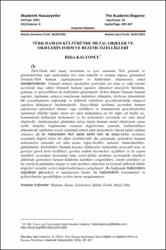| dc.contributor.author | Kalyoncu, Hülya | en_US |
| dc.date.accessioned | 2022-01-13T17:50:59Z | |
| dc.date.available | 2022-01-13T17:50:59Z | |
| dc.date.issued | 2021-08-30 | |
| dc.identifier.citation | Kalyoncu, H. (2021). Türk hamam kültüründe metal objeler ve objelerin form ve bezeme özellikleri. Akademik Hassasiyetler, 8(16), 397-427. | en_US |
| dc.identifier.issn | 2148-5933 | |
| dc.identifier.uri | https://hdl.handle.net/11729/3377 | |
| dc.identifier.uri | https://app.trdizin.gov.tr/makale/TkRZMU5qZ3dNQT09 | |
| dc.identifier.uri | https://dergipark.org.tr/tr/pub/akademik-hassasiyetler/issue/64679/944417 | |
| dc.description.abstract | Türk-İslam dini inanç sisteminin ve aynı zamanda Türk gelenek ve göreneklerinin yapı taşlarından biri olan temizlik ve arınma olgusu, geleneksel Osmanlı-Türk hamam yapılaşmasının ve kültürünün oluşmasının temel sebeplerindendir. Osmanlı mimari tipolojileri içerisinde yer alan ve vakıf sistemi içerisinde inşa edilen Osmanlı hamam yapıları, dönemsel süreçlerle büyümüş, gelişmiş ve işlevsellikleri de farklılıklar göstermiştir. Erken dönem Osmanlı hamam yapıları, toplumun yalnızca temizlenme mekânları olmuşken, ilerleyen dönemlerde ise sosyalleşmenin sağlandığı ve folklorik ritüellerin gerçekleştirildiği simgesel yapılara dönüşmeye başlamışlardır. Sosyo-kültür tarihimiz açısından hamam yapılarının geleneksel mimari yapı özellikleri ve hamamlarda gerçekleştirilen toplumsal ritüeller kadar önem arz eden hamamlara ait bir diğer alt başlık ise, hamamlarda kullanılan malzemeler ve bu malzemeler içerisinde yer alan metal objelerdir. Atalarımızdan günümüze miras kalan hamam metal objelerinin sanat tarihi disiplini bağlamında sanatsal değerlerinin yanında, kullanıldıkları dönemlerde sahibinin sosyal statüsünü temsil eden malzemeler olarak kabul edilmiş olmaları da bu malzemeleri hem sanat tarihi hem de sosyo-kültür tarihimiz açısından değerli kılan bir diğer özellikleridir. Bu çalışmada, geleneksel hamam malzemeleri arasında yer alan taslar, leğen-ibrikler, nalınlar, buhurdanlıklar, gülabdanlar, kirdenlikler (hamam kazanı), kildenceler (sabunluk), ayna gibi araç ve gereçler gerek form özellikleri, gerekse nadide bezemeleri, işçilikleri ve de yapım teknikleri açısından incelenmiş olup, sosyo-kültür tarihimiz içerisindeki önemleri dâhilinde geleneksel hamam kültürüne kattıkları zenginlikleri, estetik nitelikleri ve bu eserlerin günümüze ulaşan ve yeni nesillere aktarılan en kıymetli folklorik kültür değerleri içindeki yerleri değerlendirilmeye çalışılmıştır. Bu bağlamda malzemelere uygulanan geleneksel el sanatlarının önemi, bu malzemelerin korunmaları ve geliştirilmeleri gerekliliğine verilen önem vurgulanmıştır. | en_US |
| dc.description.abstract | Cleaning and refinement phenomenon, one of the constituents of both Turkish-Islamic belief system and Turkish customs and traditions, are the majör causes that result in the structuring of Ottoman-Turkish bath and the formation of Ottoman-Turkish bath culture. The Ottoman bath structures, which existed in the Ottoman architectural typologies and were constructed within a foundation system, developed, flourished, and exhibited differentiation in periodical processes. Whereas the early Ottoman bath structures functioned only as the cleaning places of society, they started to have symbolical features in the following periods with socialization and performance of folkloric rituals. From the aspect of our sociocultural history, another issue, which is as significant as the conventional architectural properties of Turkish bath structure, and the social rituals made there, is the materials used in Turkish baths and the metal objects among such materials. The metal objects of Turkish bath which were inherited from our ancestors possess artistic values within the context of art history discipline. Besides, they represented social status of their owner in the relevant period, therefore these objects are valuable for not only art history, but also socio-cultural history. In this study, the tools and materials such as bowl, washtub, pitcher, patten, censer, rose water flask, hammam kettle, soap dish and mirror were analyzed in terms of their forms, precious ornaments, craftsmanship and production techniques. Furthermore, it was aimed to evaluate the richness added by these objects to the traditional Turkish bath culture, their aesthetic characteristics and their place among the most treasured folkloric cultural values that survive until today and were passed on to new generations. Lastly, the importance of the traditional handicrafts applied to the materials as well as the need for protecting and developing them were highlighted. | en_US |
| dc.language.iso | tur | en_US |
| dc.publisher | A Kitap | en_US |
| dc.rights | info:eu-repo/semantics/openAccess | en_US |
| dc.subject | Geleneksel | en_US |
| dc.subject | Hamam | en_US |
| dc.subject | Kültür tarihi | en_US |
| dc.subject | Metal obje | en_US |
| dc.subject | Sanat | en_US |
| dc.subject | Art | en_US |
| dc.subject | Cultural history | en_US |
| dc.subject | Metal object | en_US |
| dc.subject | Traditional | en_US |
| dc.subject | Turkish bath | en_US |
| dc.title | Türk hamam kültüründe metal objeler ve objelerin form ve bezeme özellikleri | en_US |
| dc.title.alternative | Metal objects in Turkish bath (Hammam) culture and form and ornament characteristics of the objects | en_US |
| dc.type | article | en_US |
| dc.description.version | Publisher's Version | en_US |
| dc.contributor.department | Işık Üniversitesi, Güzel Sanatlar Fakültesi, Görsel Sanatlar Bölümü | en_US |
| dc.contributor.department | Işık University, Faculty of Fine Arts, Department of Visual Arts | en_US |
| dc.contributor.authorID | 0000-0002-6325-6009 | |
| dc.identifier.volume | 8 | |
| dc.identifier.issue | 16 | |
| dc.identifier.startpage | 397 | |
| dc.identifier.endpage | 427 | |
| dc.relation.publicationcategory | Makale - Ulusal Hakemli Dergi - Kurum Öğretim Elemanı | en_US |
| dc.contributor.institutionauthor | Kalyoncu, Hülya | en_US |



















